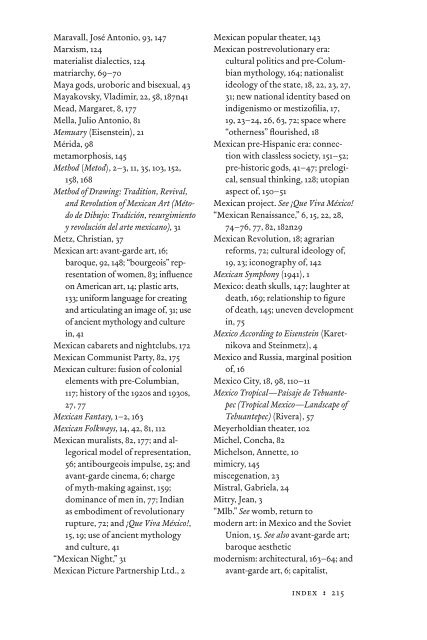In Excess: Sergei Eisentein's Mexico - Cineclub
In Excess: Sergei Eisentein's Mexico - Cineclub
In Excess: Sergei Eisentein's Mexico - Cineclub
You also want an ePaper? Increase the reach of your titles
YUMPU automatically turns print PDFs into web optimized ePapers that Google loves.
Maravall, José Antonio, 93, 147<br />
Marxism, 124<br />
materialist dialectics, 124<br />
matriarchy, 69–70<br />
Maya gods, uroboric and bisexual, 43<br />
Mayakovsky, Vladimir, 22, 58, 187n41<br />
Mead, Margaret, 8, 177<br />
Mella, Julio Antonio, 81<br />
Memuary (Eisenstein), 21<br />
Mérida, 98<br />
metamorphosis, 145<br />
Method (Metod), 2–3, 11, 35, 103, 152,<br />
158, 168<br />
Method of Drawing: Tradition, Revival,<br />
and Revolution of Mexican Art (Método<br />
de Dibujo: Tradición, resurgimiento<br />
y revolución del arte mexicano), 31<br />
Metz, Christian, 37<br />
Mexican art: avant-garde art, 16;<br />
baroque, 92, 148; “bourgeois” representation<br />
of women, 83; infl uence<br />
on American art, 14; plastic arts,<br />
133; uniform language for creating<br />
and articulating an image of, 31; use<br />
of ancient mythology and culture<br />
in, 41<br />
Mexican cabarets and nightclubs, 172<br />
Mexican Communist Party, 82, 175<br />
Mexican culture: fusion of colonial<br />
elements with pre-Columbian,<br />
117; history of the 1920s and 1930s,<br />
27, 77<br />
Mexican Fantasy, 1–2, 163<br />
Mexican Folkways, 14, 42, 81, 112<br />
Mexican muralists, 82, 177; and allegorical<br />
model of representation,<br />
56; antibourgeois impulse, 25; and<br />
avant-garde cinema, 6; charge<br />
of myth-making against, 159;<br />
dominance of men in, 77; <strong>In</strong>dian<br />
as embodiment of revolutionary<br />
rupture, 72; and ¡Que Viva México!,<br />
15, 19; use of ancient mythology<br />
and culture, 41<br />
“Mexican Night,” 31<br />
Mexican Picture Partnership Ltd., 2<br />
Mexican popular theater, 143<br />
Mexican postrevolutionary era:<br />
cultural politics and pre-Columbian<br />
mythology, 164; nationalist<br />
ideology of the state, 18, 22, 23, 27,<br />
31; new national identity based on<br />
indigenismo or mestizofi lia, 17,<br />
19, 23–24, 26, 63, 72; space where<br />
“otherness” fl ourished, 18<br />
Mexican pre-Hispanic era: connection<br />
with classless society, 151–52;<br />
pre-historic gods, 41–47; prelogical,<br />
sensual thinking, 128; utopian<br />
aspect of, 150–51<br />
Mexican project. See ¡Que Viva México!<br />
“Mexican Renaissance,” 6, 15, 22, 28,<br />
74–76, 77, 82, 182n29<br />
Mexican Revolution, 18; agrarian<br />
reforms, 72; cultural ideology of,<br />
19, 23; iconography of, 142<br />
Mexican Symphony (1941), 1<br />
<strong>Mexico</strong>: death skulls, 147; laughter at<br />
death, 169; relationship to fi gure<br />
of death, 145; uneven development<br />
in, 75<br />
<strong>Mexico</strong> According to Eisenstein (Karetnikova<br />
and Steinmetz), 4<br />
<strong>Mexico</strong> and Russia, marginal position<br />
of, 16<br />
<strong>Mexico</strong> City, 18, 98, 110–11<br />
<strong>Mexico</strong> Tropical—Paisaje de Tebuantepec<br />
(Tropical <strong>Mexico</strong>—Landscape of<br />
Tehuantepec) (Rivera), 57<br />
Meyerholdian theater, 102<br />
Michel, Concha, 82<br />
Michelson, Annette, 10<br />
mimicry, 145<br />
miscegenation, 23<br />
Mistral, Gabriela, 24<br />
Mitry, Jean, 3<br />
“Mlb.” See womb, return to<br />
modern art: in <strong>Mexico</strong> and the Soviet<br />
Union, 15. See also avant-garde art;<br />
baroque aesthetic<br />
modernism: architectural, 163–64; and<br />
avant-garde art, 6; capitalist,<br />
index : 215


